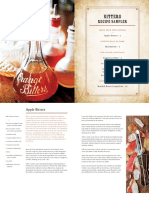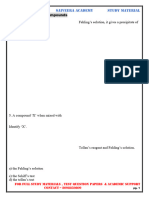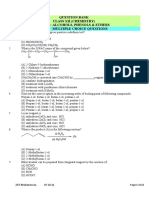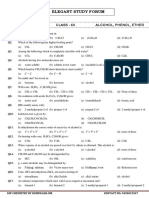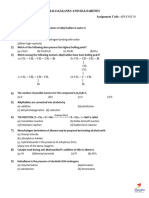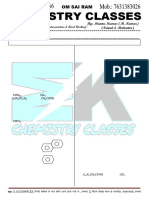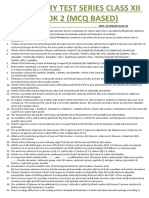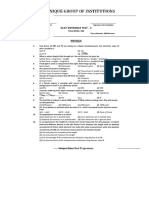0 ratings0% found this document useful (0 votes)
40 viewsChemistry-FUNGAT/ECAT: (Chapter 10+11+12 B-II)
Chemistry-FUNGAT/ECAT: (Chapter 10+11+12 B-II)
Uploaded by
XXXThis document contains 30 multiple choice questions assessing knowledge of organic chemistry concepts and reactions. The questions cover topics like conversion of alkyl halides to alkenes, electrophiles, Grignard reagents, functional group identification and reactions, mechanisms of substitution and elimination, properties of carbonyl compounds, alcohols and their derivatives, carbohydrate chemistry, IUPAC naming of organic compounds, and polymer chemistry.
Copyright:
© All Rights Reserved
Available Formats
Download as PDF, TXT or read online from Scribd
Chemistry-FUNGAT/ECAT: (Chapter 10+11+12 B-II)
Chemistry-FUNGAT/ECAT: (Chapter 10+11+12 B-II)
Uploaded by
XXX0 ratings0% found this document useful (0 votes)
40 views2 pagesThis document contains 30 multiple choice questions assessing knowledge of organic chemistry concepts and reactions. The questions cover topics like conversion of alkyl halides to alkenes, electrophiles, Grignard reagents, functional group identification and reactions, mechanisms of substitution and elimination, properties of carbonyl compounds, alcohols and their derivatives, carbohydrate chemistry, IUPAC naming of organic compounds, and polymer chemistry.
Original Title
10
Copyright
© © All Rights Reserved
Available Formats
PDF, TXT or read online from Scribd
Share this document
Did you find this document useful?
Is this content inappropriate?
This document contains 30 multiple choice questions assessing knowledge of organic chemistry concepts and reactions. The questions cover topics like conversion of alkyl halides to alkenes, electrophiles, Grignard reagents, functional group identification and reactions, mechanisms of substitution and elimination, properties of carbonyl compounds, alcohols and their derivatives, carbohydrate chemistry, IUPAC naming of organic compounds, and polymer chemistry.
Copyright:
© All Rights Reserved
Available Formats
Download as PDF, TXT or read online from Scribd
Download as pdf or txt
0 ratings0% found this document useful (0 votes)
40 views2 pagesChemistry-FUNGAT/ECAT: (Chapter 10+11+12 B-II)
Chemistry-FUNGAT/ECAT: (Chapter 10+11+12 B-II)
Uploaded by
XXXThis document contains 30 multiple choice questions assessing knowledge of organic chemistry concepts and reactions. The questions cover topics like conversion of alkyl halides to alkenes, electrophiles, Grignard reagents, functional group identification and reactions, mechanisms of substitution and elimination, properties of carbonyl compounds, alcohols and their derivatives, carbohydrate chemistry, IUPAC naming of organic compounds, and polymer chemistry.
Copyright:
© All Rights Reserved
Available Formats
Download as PDF, TXT or read online from Scribd
Download as pdf or txt
You are on page 1of 2
Chemistry–FUNGAT/ECAT
(Chapter 10+11+12 B-II)
1. How alkyl halide can be converted into alkene?
(a) Dehydration (b) Substitution (c) Elimination (d) Addition
2. Which of the following is an electrophile?
(a) NH 3 (b) H 2O (c) BF3 (d) Cl2
3. Which of the following does not form Grignard reagent?
(a) CH 3Cl (b) CH 3 F (c) CH 3 Br (d) CH 3 I
4. The common name of 2 – methyl – 2 chloropropane is:
(a) t – butyl chloride (b) Isobutyl chloride
(c) Secondary butyl chloride (d) n – butyl chloride
5. When formaldehyde reacts with ethyl magnesium iodide followed by hydrolysis, the
product formed is:
(a) 2 – propanol (b) propanoic acid (c) 1 – butanol (d) 1 – propanol
6. Point out the hybridization of oxygen in ethers:
(a) sp 2 (b) sp (c) dsp 2 (d) sp 3
7. The percentage of formaldehyde in a solution of formalin is:
(a) 10% (b) 20% (c) 40% (d) 60%
8. Cannizzaro’s reaction is not given by:
(a) Formaldehyde (b) Acetaldehyde
(c) Benzaldehyde (d) Trimethyl acetaldehyde
9. Ketones are prepared by the oxidation of:
(a) Primary alcohol (b) Secondary alcohol
(c) Tertiary alcohol (d) None of these
10. According to Lewis concept ether behaves as:
(a) acid (b) base
(c) acid base (d) neither acid nor base
11. Aldehydes and ketones have higher boiling points than corresponding compounds of
the following except:
(a) alkane (b) alkene (c) ether (d) alcohol
12. In an acid catalyzed reaction of carbonyl compounds, the acid increases:
(a) electrophilic character of the carbonyl carbon atom
(b) nucleophilic character of the carbonyl oxygen atom
(c)electrophilic character of the carbonyl oxygen atom
(d) nucleophilic character of the carbonyl carbon atom
13. Acetone and acetaldehyde can be distinguished by:
(a) R Mg X OH (b) NaOH I 2
(c) NH 2 OH (d) AgNO3 NH 4OH
14. The mechanism involved the reaction, KOH + C2H5Br →C2H4+KBr+H2O, is:
(a) SN1 (b) E1 (c) SN2 (d) E2
15. An organic compound A when treated with NaBH4 forms B, which is used in
denaturing of the spirit. The compound A is:
(a) ethanol (b) methanal (c) methanol (d) ethanal
16. Which enzyme is used to convert molasses into glucose?
(a) zymase (b) invertase (c) diastase (d) maltase
17. An organic compound has IUPAC name 2-Isopropoxy propane, its common name is:
(a) diethyl ether (b) di n-propyl ether
(c) di isopropyl ether (d) ethyl isopropyl ether
18. If an electrophile attacks alcohols, which bond will break:
(a) C – O (b) C – H (c) O – H (d) C – C
Unique Entry Test Programme
19. Which of the following is not a condition for alcoholic fermentation?
(a) optimum temperature (b) proper dilution
(c) preservative (d) none of these
20. What is the order of acidic strength?
(a) RCOOH <PhOH< HOH < ROH (b) RCOOH <PhOH> HOH < ROH
(c) RCOOH >PhOH> HOH > ROH (d) RCOOH >PhOH< HOH > ROH
21. 3-Pentanone forms a yellow precipitate with 2,4-dinitrophenyl hydrazine but does not
form white crystalline precipitate with:
(a) ammonical silver nitrate solution (b) aqueous NaOH and iodine
(c) saturated NaHSO3 solution (d) aqueous Na2CO3 and iodine
22. Which is correct order of reactivity of alcohols with ZnCl2 and HCl?
(a) tertiary alcohol > primary alcohol > secondary alcohol
(b) tertiary alcohol > secondary alcohol > primary alcohol
(c) tertiary alcohol < secondary alcohol < primary alcohol
(d) tertiary alcohol > secondary alcohol > primary alcohol
23. In the following reaction, C and D are:
CH3 – CO – CH2 – CH2 – CH3 + [O] → C + D
(a) 2 moles of CH3COOH (b) CH3COOH + CH3CH2CH3
(c) CH3COOH + CH3CH2COOH (d) HCHO+2CH3COOH
24. Reaction of CO2 with R-Mg-X is an example of
(a) electrophilic substitution reaction (b) nucleophilic addition reaction
(c) electrophilic addition reaction (d) nucleophilic substitution reaction
25. -
Alkyl halides react with SH to produce
(a) H2O+H2S (b) (C2H5)2S (c) C2H5SH (d) C2H5SO4H
26. In SN2 reaction the percentage of retention of configuration
(a) 0% (b) 100% (c) 50% (d) 66%
27. Oxidation of 3-hexanone by acidified K2Cr2O7 produces
(a) two moles of propanoic acid (b) pentanoic acid and formic acid
(c) butanoic acid and ethanoic acid (d) all these are possible
28. Which one of the following is better reducing agent?
(a) C3H8 (b) C3H7OH (c) CH2O (d) CH3COCH3
29. The monomer for the Bakelite is
(a) phenol (b) hydroxy benzyl alcohol
(c) formaldehyde (d) both a and c
30. A convenient method to convert ketones to a carboxylic acid containing one carbon
less than the parent compound is
(a) Iodoform reaction (b) Oxidation
(c) Hydrogen cyanide addition reaction (d) Reduction with Grignard reagent
Unique Entry Test Programme
You might also like
- Halogen Derivetives of Alkane MCQDocument11 pagesHalogen Derivetives of Alkane MCQParshantKumarBajaj93% (15)
- Bitters Recipe Sampler by Brad Thomas ParsonsDocument9 pagesBitters Recipe Sampler by Brad Thomas ParsonsThe Recipe ClubNo ratings yet
- Aoac968 09Document1 pageAoac968 09Jeisson Andres Rojas Santander100% (1)
- XII CH#09 P.S#01 HareshDocument3 pagesXII CH#09 P.S#01 Hareshpapukhan67zkqNo ratings yet
- Carbonyl CompoundsDocument3 pagesCarbonyl CompoundsPalash DebnathNo ratings yet
- namma_kalvi_12th_chemsitry_unit_12_study_material_english_medium_216129Document29 pagesnamma_kalvi_12th_chemsitry_unit_12_study_material_english_medium_216129codofficial61No ratings yet
- 12th Chemistry CH-2MCQsDocument3 pages12th Chemistry CH-2MCQsadilahmedfreelance213No ratings yet
- Question Bank Class Xii (Chemistry) Unit 5: Alcohols, Phenols & Ethers Multiple Choice QuestionsDocument21 pagesQuestion Bank Class Xii (Chemistry) Unit 5: Alcohols, Phenols & Ethers Multiple Choice QuestionsSahilNo ratings yet
- CH# 10 XII (Chem 12 Exam Task)Document3 pagesCH# 10 XII (Chem 12 Exam Task)daniyal.king55No ratings yet
- 12TH CBSE DPP 37. Aldehydes, Ketones and Carboxylic Acids MCQ ASSERTION REASON CS QDocument20 pages12TH CBSE DPP 37. Aldehydes, Ketones and Carboxylic Acids MCQ ASSERTION REASON CS Q123No ratings yet
- Alcohols, Phenols and EthersDocument9 pagesAlcohols, Phenols and EthersarshadumerkhanNo ratings yet
- B.Sc.V Sem Unit-5 PSSDocument4 pagesB.Sc.V Sem Unit-5 PSSMUSKAN YADAVNo ratings yet
- Carbonyl Compounds SheetDocument6 pagesCarbonyl Compounds SheetRajeev GangwarNo ratings yet
- Question paper Orgainc OnlyDocument5 pagesQuestion paper Orgainc OnlytattavramdarshanNo ratings yet
- MCQ - Alcohols, phenols and ethers (1)Document6 pagesMCQ - Alcohols, phenols and ethers (1)manasi.mysoreNo ratings yet
- Aldehydes & KetonesDocument23 pagesAldehydes & KetonesManthan JhaNo ratings yet
- Ch - 8 Question Bank RevisedDocument8 pagesCh - 8 Question Bank RevisedalltimebaksodsNo ratings yet
- 12.Mcq - Aldehydes Ketones Carboxylic AcidsDocument23 pages12.Mcq - Aldehydes Ketones Carboxylic AcidsBedosi Bidita PandaNo ratings yet
- Aldehydes, Ketones and Carboxylic AcidsDocument7 pagesAldehydes, Ketones and Carboxylic Acidskavitha2511977No ratings yet
- (Xii) Alcohol, Phenol, EtherDocument10 pages(Xii) Alcohol, Phenol, EtherAbhishek SharmaNo ratings yet
- FNT XII 01 - JP © Mdcatian's Stetho Converted - Mdcat Aspire AvenueDocument3 pagesFNT XII 01 - JP © Mdcatian's Stetho Converted - Mdcat Aspire Avenuekhand.ahmadanimehboob7788No ratings yet
- 3B-HYDROCARBON Assignment - FinalDocument49 pages3B-HYDROCARBON Assignment - Finalkraken monsterNo ratings yet
- C10 - HALOALKANES & HALOARENES (1) .9bd6790Document4 pagesC10 - HALOALKANES & HALOARENES (1) .9bd6790akashkishore363No ratings yet
- Chemistry Xii NAME: - : Alcohol, Phenol & EtherDocument1 pageChemistry Xii NAME: - : Alcohol, Phenol & EtherSahir Hemnani100% (1)
- 7. Alcohol, Phenol and Ether MCQ AssignmentDocument5 pages7. Alcohol, Phenol and Ether MCQ AssignmentAmish ShrivastavaNo ratings yet
- Hydrocarbon - Practice SheetDocument3 pagesHydrocarbon - Practice SheetAbhishek PathakNo ratings yet
- Alcohols, Phenols & Ether - Practice SheetDocument4 pagesAlcohols, Phenols & Ether - Practice SheetsrikantadonikaNo ratings yet
- Alkyl Halides Practice PaperDocument12 pagesAlkyl Halides Practice Papershubhampatelll1899No ratings yet
- CR-CHE-7-ALCOHOLS PHENOLS AND ETHERSDocument12 pagesCR-CHE-7-ALCOHOLS PHENOLS AND ETHERStpriyanshu972No ratings yet
- NEET MCQ Chemistry class 12Document10 pagesNEET MCQ Chemistry class 12smitad068No ratings yet
- Organic Chemistry One Mark Test EmDocument2 pagesOrganic Chemistry One Mark Test EmGovindNo ratings yet
- Aldehydes, Ketons and Carboxylic Acid Unit 11 MCQDocument4 pagesAldehydes, Ketons and Carboxylic Acid Unit 11 MCQAbhinav TripathiNo ratings yet
- Alcohols, Phenols, EthersDocument29 pagesAlcohols, Phenols, Etherssuryakala.ganapathyNo ratings yet
- Mcq for Carbon CompoundsDocument7 pagesMcq for Carbon CompoundsMOHAMED AADHILNo ratings yet
- Haloalkanes and Haloarenes Q 5Document3 pagesHaloalkanes and Haloarenes Q 5jayjena007No ratings yet
- ALKYNES WORK SHEET 3Document6 pagesALKYNES WORK SHEET 3All is wellNo ratings yet
- Mega Test (06-05-2024) - 240606 - 153839Document23 pagesMega Test (06-05-2024) - 240606 - 153839Regidrago 2No ratings yet
- CH# 11 XII (Chem 12 Exam Task)Document4 pagesCH# 11 XII (Chem 12 Exam Task)Zeeshan Haider ChemistNo ratings yet
- Chemistry 2nd Year Question Bank CH#8Document2 pagesChemistry 2nd Year Question Bank CH#8rohmashahid69No ratings yet
- CH-12 - MCQS Ald, Ket & Car - AcidsDocument3 pagesCH-12 - MCQS Ald, Ket & Car - AcidsPranav ShankarNo ratings yet
- Chemistry 12 CH10MCQSDocument15 pagesChemistry 12 CH10MCQSmuqaddamshaikh21No ratings yet
- Waghs Chemistry: Chapter-Aldehydes, Ketones, Carboxylic AcidsDocument3 pagesWaghs Chemistry: Chapter-Aldehydes, Ketones, Carboxylic AcidsRiddhesh100% (1)
- 3 - Aldehydes and Ketones (Assignment) Booklet-2Document15 pages3 - Aldehydes and Ketones (Assignment) Booklet-2kraken monster100% (1)
- Worksheet: Subject: Batch: Date of Issue: Unit: ID No.: Due DateDocument4 pagesWorksheet: Subject: Batch: Date of Issue: Unit: ID No.: Due Datedharmendra gaikwadNo ratings yet
- 12 DPP29 AALCprep EVOLVEDocument4 pages12 DPP29 AALCprep EVOLVESubhankar RoyNo ratings yet
- Organic Test 1Document4 pagesOrganic Test 1binodNo ratings yet
- AldehydesDocument22 pagesAldehydesjksiddharth24No ratings yet
- Alcohols, - Phenols - and - Ethers - Assignment-2 23-24-24Document8 pagesAlcohols, - Phenols - and - Ethers - Assignment-2 23-24-24malphedwarparthNo ratings yet
- Alkyl HalideDocument8 pagesAlkyl HalideMegh Raj BhattNo ratings yet
- ALDEHYDES, KETONES, CARBOXYLIC ACIDSDocument46 pagesALDEHYDES, KETONES, CARBOXYLIC ACIDSmadhavsuneja207No ratings yet
- Haloalkanes and HaloarenesDocument5 pagesHaloalkanes and Haloareneskavitha2511977No ratings yet
- C12 - ALDEHYDES KETONES AND CARBOXYLIC ACIDS (1) .9cfd4beDocument4 pagesC12 - ALDEHYDES KETONES AND CARBOXYLIC ACIDS (1) .9cfd4beakashkishore363No ratings yet
- 13 DPP 09a-09d Halk & Harn EvolveDocument17 pages13 DPP 09a-09d Halk & Harn Evolvemangeshchavan980No ratings yet
- Chem Book 2 TestDocument3 pagesChem Book 2 TestHishq DhimanNo ratings yet
- Alcohols, Phenols, EthersDocument28 pagesAlcohols, Phenols, Etherskaushikkumar20001996No ratings yet
- Alkanes 24.12...........Document4 pagesAlkanes 24.12...........vengateshwaran kNo ratings yet
- CH 11. Aldehydes - Ketones Tatva (NM)Document48 pagesCH 11. Aldehydes - Ketones Tatva (NM)chandan mallikNo ratings yet
- Chem Class 12 WorksheetDocument8 pagesChem Class 12 WorksheetBHAVYA KUSHWAHANo ratings yet
- 12th Chemistry CH-3MCQsDocument4 pages12th Chemistry CH-3MCQskirabankai5No ratings yet
- 12th FNT 06 Chem(STR) 22-23Document3 pages12th FNT 06 Chem(STR) 22-23Hifza BalouchNo ratings yet
- NEET National Eligibility Cum Entrance Test Chemistry Class 11 + 12 Volume I + Volume IIFrom EverandNEET National Eligibility Cum Entrance Test Chemistry Class 11 + 12 Volume I + Volume IINo ratings yet
- Physics - FUNGAT: (Chapter 1+2 B-I)Document3 pagesPhysics - FUNGAT: (Chapter 1+2 B-I)XXXNo ratings yet
- Ecat Entrance Test - 3: PhysicsDocument13 pagesEcat Entrance Test - 3: PhysicsXXXNo ratings yet
- Ecat Entrance Test - 2: PhysicsDocument12 pagesEcat Entrance Test - 2: PhysicsXXXNo ratings yet
- Ecat Entrance Test - 1: Physics Flt-1Document9 pagesEcat Entrance Test - 1: Physics Flt-1XXXNo ratings yet
- Chemistry-FUNGAT/ECAT: (Chapter 7+8+9 B-II)Document2 pagesChemistry-FUNGAT/ECAT: (Chapter 7+8+9 B-II)XXXNo ratings yet
- Chemistry - FUNGAT/ECAT: (Chapter 4+5+6 B-II)Document2 pagesChemistry - FUNGAT/ECAT: (Chapter 4+5+6 B-II)XXXNo ratings yet
- Chemistry-FUNGAT/ECAT: (Chapter 10+11 B-I)Document2 pagesChemistry-FUNGAT/ECAT: (Chapter 10+11 B-I)XXXNo ratings yet
- Chemistry-FUNGAT/ECAT: (Chapter 8+9 B-I)Document2 pagesChemistry-FUNGAT/ECAT: (Chapter 8+9 B-I)XXXNo ratings yet
- Chemistry-FUNGAT+ECAT: (Chapter 1-5 B-I)Document2 pagesChemistry-FUNGAT+ECAT: (Chapter 1-5 B-I)XXXNo ratings yet
- Chemistry-FUNGAT/ECAT: (Chapter 6+7 B-I)Document2 pagesChemistry-FUNGAT/ECAT: (Chapter 6+7 B-I)XXXNo ratings yet
- Chemistry-FUNGAT+ECAT: (Chapter 1+2+3 B-I)Document2 pagesChemistry-FUNGAT+ECAT: (Chapter 1+2+3 B-I)XXXNo ratings yet
- After Transmigration The Male Lead and I Had A HE Chapter 54 - Chapter 89Document140 pagesAfter Transmigration The Male Lead and I Had A HE Chapter 54 - Chapter 89Ava LamperougeNo ratings yet
- Question paper Orgainc OnlyDocument5 pagesQuestion paper Orgainc OnlytattavramdarshanNo ratings yet
- V1 Base FormDocument5 pagesV1 Base FormDonna HarveyNo ratings yet
- DT2 The Drawing of The Three (Screenplay)Document167 pagesDT2 The Drawing of The Three (Screenplay)Sean NegleyNo ratings yet
- NSTP Common Module 2 Drug EducationDocument33 pagesNSTP Common Module 2 Drug EducationMerylle Shayne GustiloNo ratings yet
- INVESTIGATION REPORT - M - S. Raya Foods Pvt. LTD, PondicherryDocument5 pagesINVESTIGATION REPORT - M - S. Raya Foods Pvt. LTD, PondicherryElamaran PerumalNo ratings yet
- CzasownikiDocument2 pagesCzasownikiLena KujtkowskaNo ratings yet
- Section B - Aptitude 10 Questions - 45 Minutes Each Question Carries One MarkDocument2 pagesSection B - Aptitude 10 Questions - 45 Minutes Each Question Carries One MarkMayur PatilNo ratings yet
- Edward Teach Brewing - Violation ReportDocument16 pagesEdward Teach Brewing - Violation ReportNicholas AzizNo ratings yet
- Alcoholic Price List - WholesaleDocument1 pageAlcoholic Price List - WholesaleBrigita NemetNo ratings yet
- Binks Drinks Menu Web Version 050123Document15 pagesBinks Drinks Menu Web Version 050123TestertNo ratings yet
- This Love Hurts by NikitaDocument387 pagesThis Love Hurts by NikitaxppxtdtbfjNo ratings yet
- Practice Test - Midterm I - Grade 8 (Answer Key)Document6 pagesPractice Test - Midterm I - Grade 8 (Answer Key)Bùi Công TríNo ratings yet
- TERM ONE YEAR 11 QP 2015 MockDocument15 pagesTERM ONE YEAR 11 QP 2015 MockmonikaNo ratings yet
- Properties Methanol Phenol N-Butyl Sec-Butyl Tert-Butyl: Experiment 10 Alcohols and Phenols Data and ResultsDocument2 pagesProperties Methanol Phenol N-Butyl Sec-Butyl Tert-Butyl: Experiment 10 Alcohols and Phenols Data and ResultsPrincess Loyola TapiaNo ratings yet
- 585 - Reading Comprehension Passage 15 MCQ Test With Answers A Disastrous Day at The GablesDocument3 pages585 - Reading Comprehension Passage 15 MCQ Test With Answers A Disastrous Day at The GablesLindaDawnWheelerBryantNo ratings yet
- The Bartender'S Field ManualDocument311 pagesThe Bartender'S Field ManualSiamak BaharlooNo ratings yet
- Test Unit 1Document2 pagesTest Unit 1Ken BiNo ratings yet
- Product Catalogue SpiritsDocument28 pagesProduct Catalogue Spiritsrealestatebuzz.inNo ratings yet
- Coca Cola Marketing PlanDocument14 pagesCoca Cola Marketing PlanShubhrant ShuklaNo ratings yet
- LabelDocument4 pagesLabelCalvin Kristanto AlimNo ratings yet
- E1061, E1063 - Installation Manual MA00815-A (04.06)Document22 pagesE1061, E1063 - Installation Manual MA00815-A (04.06)gNo ratings yet
- Cocktails EbsDocument13 pagesCocktails Ebsjessleon1810No ratings yet
- Kikibees Full MenuDocument17 pagesKikibees Full MenudrkojoansongNo ratings yet
- Food Beverages ReportDocument14 pagesFood Beverages ReportIp AdrrNo ratings yet
- Wine Conversion ChartDocument1 pageWine Conversion ChartKIshor SanapNo ratings yet
- SAB Version For ClientsDocument2 pagesSAB Version For ClientsAl MustafaNo ratings yet
- Page - 1: The Integrated Marketing Communication Final Assignment Consists of Three (3) PartsDocument6 pagesPage - 1: The Integrated Marketing Communication Final Assignment Consists of Three (3) Partsally brownNo ratings yet

